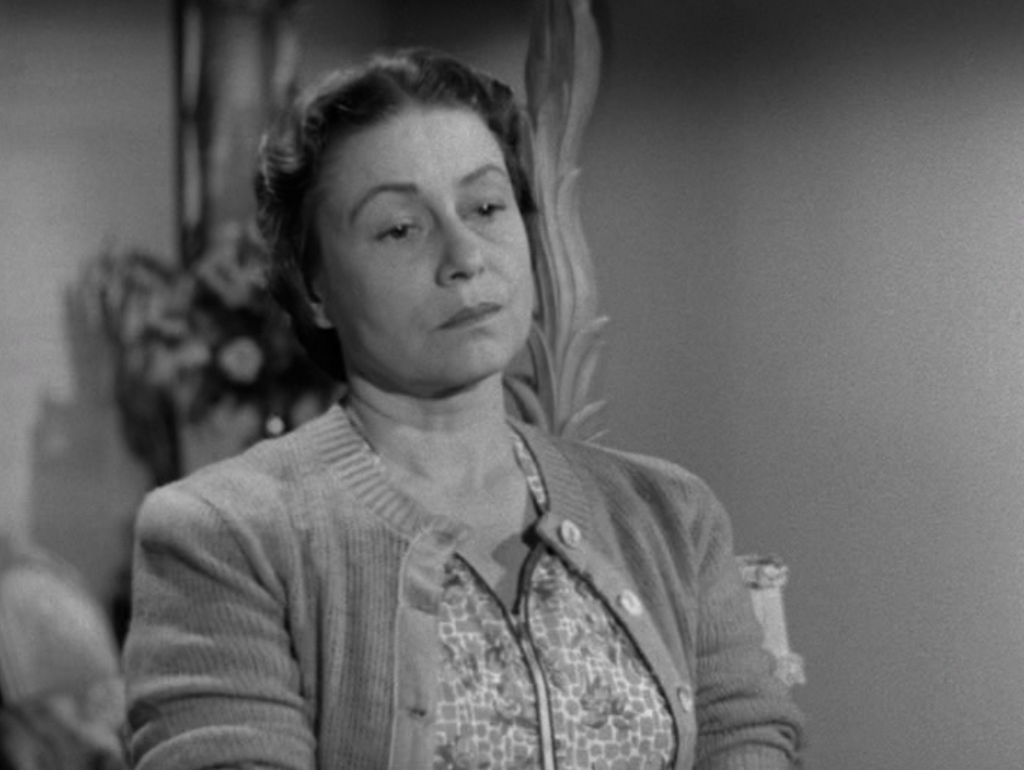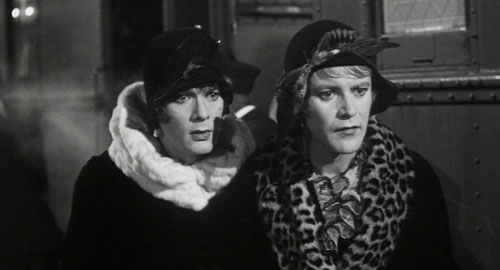
On Monday, June 7, 1937, Spencer Tracy made a very short diary entry– “Jean Harlow died. Grand girl.” Harlow’s tragic death at the young age of 26 devastated the entire MGM company. One MGM writer was quoted later saying, “The day Baby (Harlow’s nickname) died…there wasn’t a sound in the commissary for three hours.” Harlow’s fiance, William Powell, was devastated. He was in the middle of filming his latest film, Double Wedding, with frequent co-star Myrna Loy. Loy was also good friends with Harlow. The two stars asked for time to grieve and production was temporarily halted. Even after completing the film, both Powell and Loy felt like they hadn’t turned in their best performances. Clark Gable and Una Merkel were also good friends of Harlow’s and had been with her during her final days. Both Gable and Merkel appeared with Harlow in what turned out to be her final film, Saratoga (1937).
Unfortunately, Harlow’s passing at such a young age and rumors about her cause of death have overshadowed her legacy. A rumor persists that her death was caused by poisoning from the peroxide she used to achieve her trademark platinum blonde look. The truth is that Harlow unfortunately was not in the best of health throughout her short life. When she was 15, she contracted scarlet fever and it is thought that the illness permanently damaged her kidneys. Harlow also suffered bouts of meningitis, polio, and pneumonia during her youth. Healthwise, the poor girl was a mess.

Watching Harlow on the silver screen however, one would never know that she suffered from so many various ailments. On-screen, Harlow’s beauty and effervescent personality are on full display. Her trademark platinum blonde hair lights up the screen. Unfortunately, Harlow’s hair suffered greatly from the treatment given to achieve this look. Harlow’s hairdressers came up with a concoction of hydrogen peroxide, sodium hypochlorite bleach, ammonia, and Lux soap flakes. Yikes. Last time I checked, one was not supposed to mix bleach and ammonia together. But this is what Harlow endured to be a star. However, her hair also started to fall out. Towards the end of her life, Harlow had given up the harsh peroxide treatment and returned to her natural hair color or wore wigs.
Despite all the issues the platinum blonde hair caused Harlow, it led to her breakthrough film, aptly titled, Platinum Blonde (1931). Prior to this role, she had appeared in small roles, usually as the floozy, but she did have a good role in James Cagney’s breakthrough film, The Public Enemy (1931). In Harlow’s earliest films, she’s not particularly good. It’s very obvious that she isn’t experienced in acting. However, she just has that je ne sais quoi, aka “that certain something,” aka “the ‘it’ factor,” aka “star quality.” In 1932, Harlow finally hit her stride and became a bona fide star when she appeared in Red-Headed Woman.

In Red-Headed Woman, Harlow plays Lillian ‘Lil’ Andrews, a young woman who lives in a small town in Ohio, in a home literally on the wrong side of the tracks. She desperately wants to improve her social standing and will stop at nothing, and I mean nothing, to do so. Curiously enough, in this film which is widely seen as Harlow’s star making role, her character dyes her platinum hair red. In my opinion, Harlow actually looks better with the darker hair. As Lil, Harlow sizzles on screen. There is a scene where she changes her top and for a brief second, the side of her right breast is visible. There’s another scene where Lil asks a store clerk if the dress she’s interested in is sheer and the clerk says that yes it is. That’s all Lil needs to hear and she gladly wears it. Throughout the film, Lil shamelessly seduces married men, older rich men, anyone who can move her to the other side of the tracks.
LIL: “Listen Sally, I made up my mind a long time ago, I’m not gonna spend my whole life on the wrong side of the railroad tracks.”
SALLY: “Well, I hope you don’t get hit by a train while you’re crossing over.”
Jean Harlow as “Lil” and Una Merkel as “Sally” in “Red-Headed Woman” (1932)

1932 was a big year for Harlow, after Red-Headed Woman, Harlow’s star status further solidified with the release of Red Dust, co-starring Harlow’s friend and frequent co-star, Clark Gable. Red Dust is mostly remembered today for Harlow’s famous scene where her character bathes nude in a rain barrel. However, Harlow’s performance in Red Dust is so much more than that one short scene. In this film, Harlow plays a prostitute, Vantine, who stumbles upon Gable’s rubber plantation in Vietnam. She’s on the run. Why, exactly? We don’t know, but we can assume that her occupation probably has something to do with it. While on the plantation, Harlow and Gable crackle and sizzle on screen. Their chemistry is off the charts, even in a ridiculous scene where they discuss their preferred type of blue cheese.
VANTINE [bathing in the rain barrel]: “What’s the matter? Afraid I’ll shock the duchess? Don’t you suppose she’s ever seen a French postcard?”
DENNIS: “You’ll let those curtains down if it’s the last bath you’ll ever take!”
Jean Harlow as “Vantine” and Clark Gable as “Dennis” in “Red Dust” (1932)
Harlow’s best roles were during the pre-code era, when her sexuality and sensual nature were allowed to be on display. 1933 was a banner year for Harlow as well, as she was re-teamed with Gable in Hold Your Man, and appeared as part of the all-star cast in Dinner at Eight. She has a particularly memorable scene with Marie Dressler, a fellow MGM star who couldn’t be more different than Harlow. She also appeared in Bombshell, playing a fictionalized version of Clara Bow. An argument could be made however, that Harlow was also playing a fictionalized version of herself. The success of Bombshell led to Harlow being declared a “blonde bombshell.”
KITTY: “I was reading a book the other day.”
CARLOTTA: “Reading a book?!”
KITTY: “Yes. It’s about civilization or something. A nutty kind of book. Do you know that the guy says that machinery is going to take the place of every profession?”
CARLOTTA: “Oh, my dear, that’s something you never need worry about.”
Jean Harlow as “Kitty” and Marie Dressler as “Carlotta” in “Dinner at Eight” (1933)

After the production code went into effect in mid-1934, Harlow’s on-screen image was toned down. She was still the brassy blonde, but she was no longer the sexpot. She didn’t slink around in silk bias cut gowns where it was very obvious she wasn’t wearing underwear. While she might have still been going commando under her costumes, the Harlow-character was now a different type of woman. In The Girl From Missouri, made in 1934 after the production code went into effect, had a storyline similar to Red-Headed Woman. Harlow’s character, Eadie, lives in Kansas City and desperately wants to leave her home, complete with an abusive stepfather, behind. She decides to move to New York City to search for a millionaire. If The Girl From Missouri had come out earlier, Harlow’s character would have probably acted more brazenly in pursuit of her millionaire. The production code version of this film features a tamer, more common rom-com plot.
TR: “You want to scratch me off your list. I’m not a ladies’ man.”
EADIE: “Oh, Mr. Paige. Don’t be such a pessimist.”
Franchot Tone as “TR” and Jean Harlow as “Eadie” in “The Girl From Missouri” (1934).
Both The Girl From Missouri and 1936’s Libeled Lady, feature a common production code Jean Harlow character, the sassy girl who is a bit gaudy and unsophisticated, but has charm in spades. Libeled Lady is the first film Harlow made where she does not sport her trademark platinum blonde hair. By this point, the harsh peroxide and bleach had led to Harlow’s hair resembling straw. It eventually started to fall out in clumps. Alarmed at her hair loss, Harlow understandably ceased the bleach treatments and reverted to her own hair color, or she would wear wigs. In addition to Harlow, Libeled Lady features three of MGM’s other big stars: Spencer Tracy, William Powell, and Myrna Loy.
WARREN: “Gladys, do you want me to kill myself?”
GLADYS: “Did you change your insurance?”
Spencer Tracy as “Warren” and Jean Harlow as “Gladys” in “Libeled Lady” (1936).

In 1934, Harlow and Powell started dating. At some point they became engaged, but did not marry before Harlow’s death. Powell had gifted Harlow an enormous star sapphire ring and was truly devoted to her. Had Harlow not died so young, it’s interesting to think about whether Harlow and Powell would have married. Would their marriage have lasted? Sadly, we’ll never know because by the beginning of 1937, it was the beginning of the end for Harlow. She was cast in the film Saratoga again with Gable. She would not complete the film. In March, she developed sepsis after having her wisdom teeth extracted. After a brief hospitalization, she resumed filming.
In May, Harlow complained of symptoms–fatigue, nausea, fluid retention and abdominal pain, but sadly the studio doctor didn’t seem to think there were any issues (Really, doc?). He diagnosed her with a gallbladder infection and the flu. Whether Harlow’s life would have been prolonged or even saved were she diagnosed correctly, is hard to say. It is apparent though that she was already suffering from kidney failure and with dialysis not being a thing and antibiotics still in their infancy, most likely Harlow was doomed. At the end of May, she filmed a scene in which her character is suffering from a fever. Harlow did not need to act to do this scene. She was very very ill and had to lean against Gable for support. William Powell was called to escort Harlow home. She never returned to the set.
On the evening of June 6, 1937, Harlow slipped into a coma. She died the next morning just after 11:30am.

Harlow’s death is tragic. Who knows what she could have done had she lived a long life? I would have loved to have seen Harlow continue with her more natural appearance. She would get rid of the pencil-thin high arched eyebrows. I could see her with longer hair. I would have loved to have seen Harlow in a film noir. Let’s hope that when she reached her 40s in the 1950s, that she didn’t adopt the awful poodle cut that so many of her peers did and aged them 15-20 years in the process. Perhaps in the 1950s, Harlow could have worked with a young actress who idolized her–Marilyn Monroe. Monroe worshipped Harlow as a child and tried to emulate her, complete with the platinum blonde hair.
I love Jean Harlow. She is a legend. While Harlow continues to end up on lists of stars who died tragically young, her legacy is so much more. Harlow is the original blonde bombshell. She established the blueprint for the sassy, sometimes brassy, va va voom blonde who inevitably will win the heart of the leading man of the film. After Harlow’s breakthrough in Platinum Blonde, many other platinum blonde starlets popped up: Alice Faye, Ida Lupino, Bette Davis, Joan Blondell, Ginger Rogers, even Joan Crawford sported the look for awhile! But only Harlow persists as the ultimate platinum blonde. Marilyn Monroe might share the platinum blonde mantel, but Harlow is the original.


















